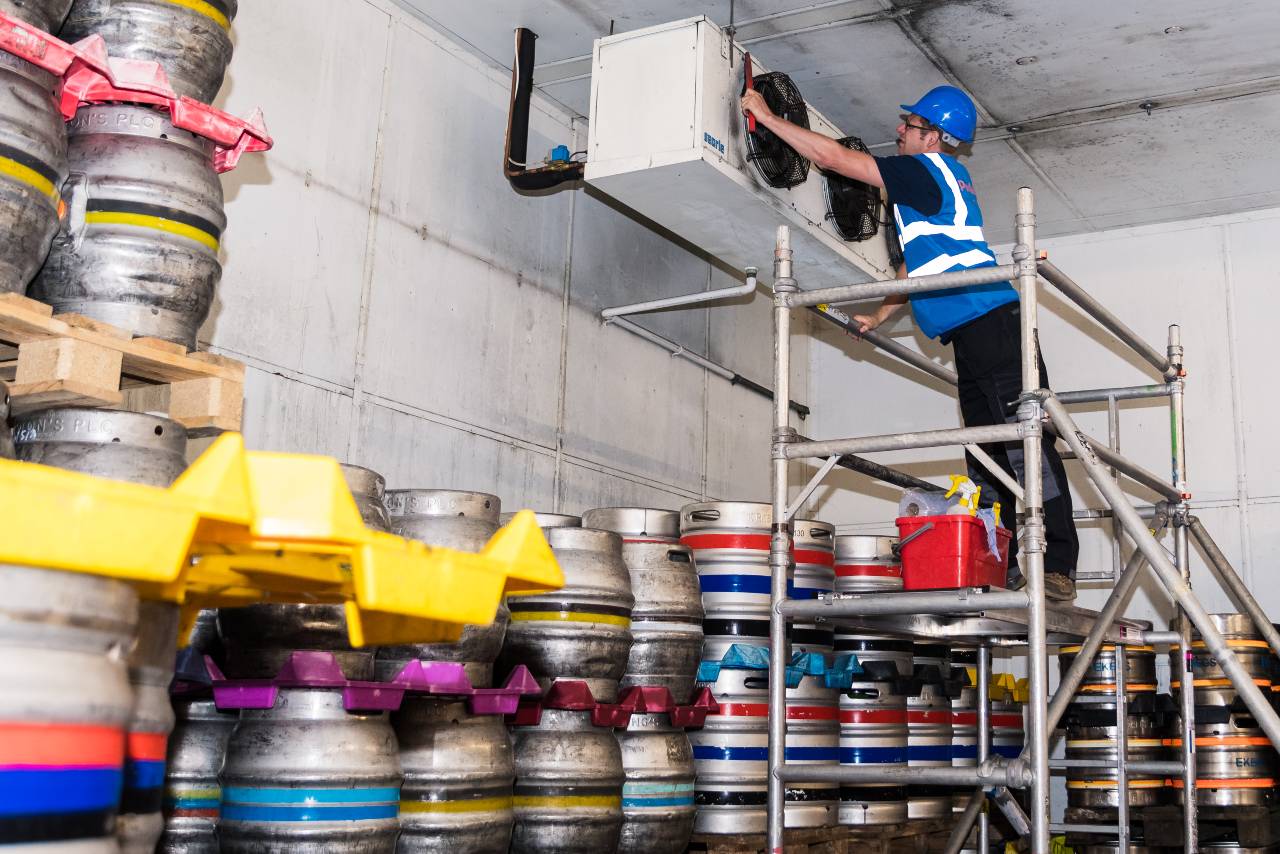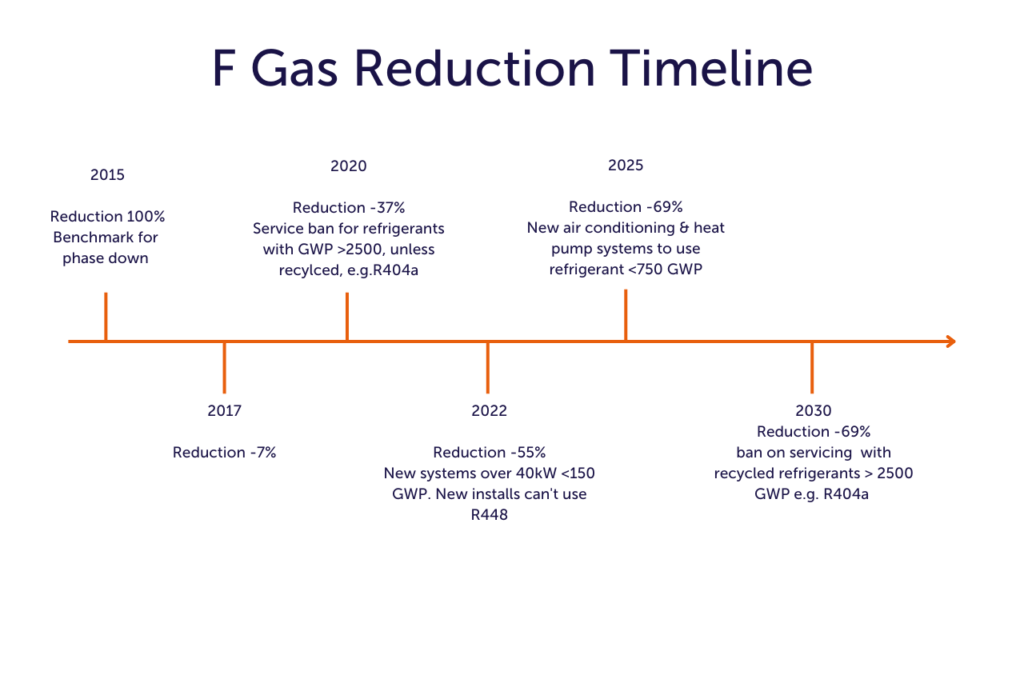
F gas regulations in the UK place legal obligations on those using equipment containing F gases, those that work with F gases, and on those that produce, import or export F gases.
The following article provides details on your obligation with regards to the F gas regulations and further information can be found on the government website.
What is F Gas?
Fluorinated gases (F gases) are man-made gases used in a wide range of cooling and heating applications (e.g. Refrigeration and Air Conditioning). They have a much higher global warming potential (GWP) than carbon dioxide which means that if not strictly managed, they could contribute greatly to further climate change. This is why F gas regulations are needed.
F gases are used for many industrial, commercial and domestic applications and because they do not damage the ozone layer they are now often used as replacements for ozone-depleting substances.
What Are The F Gas Regulations In The UK?
F gas regulations came into force on 17 May 2006 and were later revised in 2014. The aims of the regulations are to reduce and contain emissions by:
Better containing F gases and their applications
Recovering F gases from products at the end of their life.
Training and certifying professionals to work safely with F gases.
Report on the production, import and export of F gases.
Clearly-labelled products and equipment that contain F gases with the type and amount of gas contained.
According to the F gas regulations, gases with a GWP of over 2500 are banned as of 1 January 2020 and equipment should be retrofitted to switch to a gas with a lower GWP or replaced with newer equipment.
What Are My F Gas Responsibilities?
The F gas regulations outline your responsibilities when working with F gases. These are:
First and foremost, use trained technicians that are F gas registered. Only those qualified to work on machinery or equipment with F gases can do so.
Check for leaks on the required schedule. (see below)
If your system contains more than 300kg of F gases, leak detection needs to be installed (and regularly tested)
Keep records of your F gases and activities related to F gases (See below).
Label your systems and equipment with at least the type of F gas used and the quantity in the equipment.
When your equipment reaches the end of its life, you must ensure that any F gases are reclaimed, recycled or destroyed by a qualified professional.
How Do I Know If I Have F Gas In My Equipment?
All air conditioning and refrigeration equipment will have an information plate fixed to it. This will tell you which refrigerant is used in the equipment and its amount in kilograms. The number is referenced as an R, e.g. R410a.
Checking Equipment For F Gas Leaks
How often you are required to check for leaks depends on the amount of F gas in the equipment and its global warming potential.
The basics are:
Between 5-50 tonnes CO2 equivalent, check once per year
50-500 tonnes, check every six months
Over 500 tonnes, check every three months
How To Calculate CO2 Equivalent Of F Gas
To calculate the CO2 equivalent of an F gas, you need to use the following calculation:
Multiply the mass of the gas (in metric tonnes) by the gas’ global warming potential (GWP).
The mass of an F gas is usually expressed in kilograms, so to convert this to metric tonnes you will need to divide this figure by 1000.
Example Calculation
HFC 32 has a GWP of 675. 10kgs of HFC 32 can be calculated as follows:
(10/1000) multiplied by 675 = 6.75 tonnes CO2 equivalent.
This would require a check every 12 months. You can find GWP numbers and thresholds for common F gases on the government website.
F Gas Phase Down
As part of the F Gas regulations, the quantity of HFCs on the market in the EU will be cut in a series of steps and by 2030, only 20% of the quantity of HFCs that were sold in 2015 will be available. The remaining supply will be for specialist applications and not mainstream refrigeration.
The availability of HFCs is now limited by F gas regulations, increasing costs and forcing users to update or upgrade their cooling systems to use F gases with a much lower GWP

What Equipment Needs F Gas Records?
F gas regulations identify equipment that requires records to be kept if it contains F gas equivalent to 5 tonnes or more of carbon dioxide:
Stationary refrigeration equipment
Stationary air conditioning equipment
Stationary heat pumps
Stationary fire protection equipment
Refrigeration units of trucks and trailers
Electrical switchgear
Organic Rankkine cycle
What Records To Keep?
F gas regulations also identify what records you need to keep. These records include:
Quantity and type of gas in the equipment when it is installed
Quantity and type of gas added during maintenance (for example leak repairs)
Dates and results of all mandatory leak checks
What you’ve done to recover and dispose of gas, for example, record the registered waste carrier used to dispose of it.
If the gas used has been recycled or reclaimed, record:
Quantity of gases recovered
Name, address and certificate number of the recycling or reclamation facility.
If you’re the user or operator of the equipment, record:
Name, address and certificate number of any companies used to install, service or decommission your equipment.
If you don’t have one, you can download an F gas log book for your use. We can help with your records as part of our planned maintenance contracts and will advise you if you need to add a system to your records.
How Long To Keep F Gas Records?
Records of the above must be kept for five years.
Who Is Responsible For F Gas Reporting?
The person responsible for reporting is the operator that uses the equipment and not necessarily the owner. The person responsible is defined as “the natural or legal person exercising actual power over the technical functioning of the equipment and systems.”
Reporting F Gas Activities
If you have conducted any of the following activities, under F gas regulations you must report your F gas activities in the previous calendar year:
Produced, imported or exported 1 tonne of F gas, or F gas equivalent to 100 tonnes or more of carbon dioxide (CO2).
Destroyed 1 tonne of F gas, or F gas equivalent to 1,000 tonnes or more of CO2.
Placed F gases equivalent to 500 tonnes or more of CO2 in products or equipment on the market in Great Britain.
Used F gases equivalent to 1,000 tonnes of CO2 as feedstock in the previous calendar year.
You must also submit a verification document from an independent verifier if you’ve carried out any of the following activities:
Placed hydrofluorocarbons (HFCs) equivalent to 10,000 tonnes or more of CO2 on the market in Great Britain.
Placed pre-charged refrigeration, air conditioning or heat pump equipment with HFCs equivalent to 100 tonnes or more of CO2 on the market in Great Britain and the HFCs contained in the equipment have not been placed on the market before.
You supplied any quantity of HFCs directly to an exporter in the previous calendar year.
You can find out more about reporting your F gas activities on the government website.
If you have any questions about F gas regulations and your obligations, please contact us to discuss this further.
About Pinder Cooling
Pinder Cooling provides commercial air conditioning and commercial refrigeration installation services to clients across the North of England, including Leeds, Manchester, Wakefield, Liverpool, Sheffield and Hull.